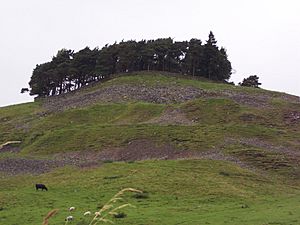Kirkcarrion facts for kids
Kirkcarrion is a special place in County Durham, England. It's a small group of pine trees, called a copse, surrounded by a stone wall. This peaceful spot sits on top of a hill near the town of Middleton-in-Teesdale. The trees were planted a long time ago, during the Victorian era. Underneath these trees is an ancient burial mound, known as a tumulus or round barrow. People believe it's the resting place of a very old leader, Prince Caryn, who lived during the Bronze Age, even before the Romans came to Britain! Kirkcarrion is located on Lunedale Ridge, looking down over Middleton-in-Teesdale, which is about 400 feet below.
Contents
What's in a Name?
Have you ever wondered where the name Kirkcarrion comes from? It's thought to mean "burial mound of Caryn." This comes from an old language, possibly Carreg Caryn. Sometimes, people also call this place "Caryn's Castle." This name might come from Caer Caryn, which means "Caryn's Fort" or "Caryn's Stronghold" in an ancient British language called Brythonic.
Ancient History of Kirkcarrion
Kirkcarrion is a significant historical site because it's a Bronze Age round barrow. The Bronze Age was a time in history when people started using bronze to make tools and weapons. This period was roughly from 3300 BC to 1200 BC.
Who Was Prince Caryn?
Some people have suggested that Prince Caryn was a leader of the Brigantes. The Brigantes were a powerful tribe who lived in northern England during the Iron Age. However, the Iron Age came much later than the Bronze Age, so it's unlikely that Prince Caryn, a Bronze Age chieftain, was part of the Brigantes tribe.
Discoveries at the Site
In the 1800s, during the 19th century, people explored the Kirkcarrion site. They found some interesting things! They discovered a type of burial called a cist burial. A cist is like a small stone box or chamber where a body or remains were placed. Inside this cist, they reportedly found a funerary urn, which is a special pot used to hold the ashes or bones of someone who had died. This urn contained charred bones, meaning they had been burned.
What Happened to the Finds?
The exact location of these ancient artifacts today is a bit of a mystery. It's believed they ended up with a nobleman named Lord Strathmore. After these discoveries, Lord Strathmore took steps to protect the site. He had stone walls built around the area and then planted the pine trees we see there today.
A Local Legend
Kirkcarrion isn't just a historical site; it also has a cool local legend! People say that within the circle of trees, there's a special spot where the wind never blows. No matter how stormy or windy the weather is outside the circle, this one small area inside remains perfectly calm. It's a fun story that adds to the mystery and charm of Kirkcarrion.


